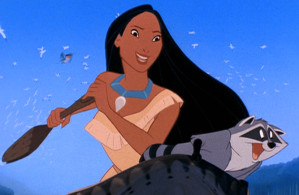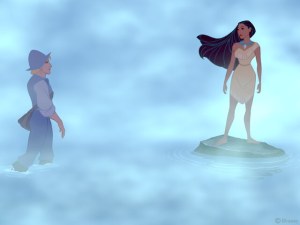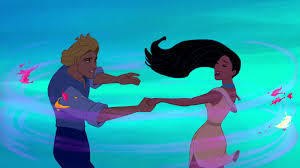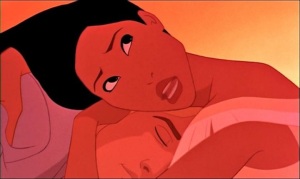Pocahontas
Disney once again won an Oscar for Best Original Score (Alan Menken once again, he was assisted by Stephen Schwartz, who would go on to write lyrics for Hunchback of Notre Dame, Prince of Egypt, and Broadway smash hit Wicked) and Best Original Song for Colors of the Wind, another one of my favorite Disney soundtracks. This was also the first movie I can remember seeing in the theatre; I would have been about six when it came out. It has another all-star cast, Mel Gibson (before he said stupid things) voices John Smith, Christian Bale (yep, Batman) voices Thomas, Billy Connolly voices Ben (the dark-haired friend of John Smith), Linda Hunt (Hetty from NCIS: Los Angeles, I’ll admit, I just figured this one out) voices Grandmother Willow, and Disney alum David Ogden Stiers is back, voicing Governor Ratcliffe and his companion Wiggins. Disney considers Pocahontas a princess, since her father is chief of the Powhatan tribe of Indians (I’m glad she’s recognized, but she’s not really a princess.)
The film is based on the founding of Jamestown and opens on London, seeing the Susan Constant off. Virginia Company is the reason I remember that Jamestown was founded in 1607 and that they were searching for “glory, gold, and God,” though mainly gold (surprising a teacher in eighth grade). John Smith is portrayed as an adventurer and helps rescue Thomas when the lad is swept overboard in a storm [btw, amazing soundtrack]. He’s apparently been other “New Worlds” and is skilled with pushing back the “savages” or “Injuns” as the English sometimes refer (we cringe at that now; in Disney’s defense, the rest of the movie is devoted to proving that concept wrong). He has no reason to think that this trip will be any different (just you wait). Governor Ratcliffe shows us shades of his true nature early, admitting to Wiggins he needs the men cheerful so they’ll “dig up my gold.”
Next we meet the Powhatan Indian village, giving insight into Native culture and extolling the virtues of living off the Earth, promoting “walk in balance all our days.” The titular character does not view life as steady. No, Pocahontas rather jump off a cliff (accompanied by her animal friends Flit and Meeko [a hummingbird and raccon]) instead of taking the meandering course down. Definitely more fun to a kid. When she meets up with her father, he informs her that the bravest warrior, Kocoum wishes to marry her. It would be a good match, Powhatan believes; “he is loyal and strong and will build you a good house…with him, you will be safe from harm.” Pocahontas, on the other hand, sees the warrior as stern and serious and not the excitement she thought her dream means. Pocahontas wants to be able to choose her own path; her father cautions that the wisest way is to become Steady as the Beating Drum, like the river. She is the daughter of the chief, her people expect her to take her place. To aid her decision, Powhatan gifts his daughter her mother’s necklace, which was worn on her wedding day.
 But the river is not steady; there are always new things Just Around the Riverbend, waiting to be discovered, including a waterfall and exhilarating rapids; another favorite scene of mine. [I loved to sing this song on the bus; I got looks.] Pocahontas comments that in exchange for being safe, we lose our sense of adventure. “For a handsome sturdy husband/who builds handsome study walls/and never dreams that something might be coming/just around the riverbend.” “Should I choose the smoothest course/steady as the beating drum…is all my dreaming at an end?” The river leads the young woman to Grandmother Willow, a wise spirit with a bit of spunk. There, she explains her dream of a spinning arrow. Grandmother Willow instructs her to Listen with Your Heart to determine what her dream means and the path she should follow. The wind tells her that there are strange clouds coming. Indeed there are; the sails of the Susan Constant.
But the river is not steady; there are always new things Just Around the Riverbend, waiting to be discovered, including a waterfall and exhilarating rapids; another favorite scene of mine. [I loved to sing this song on the bus; I got looks.] Pocahontas comments that in exchange for being safe, we lose our sense of adventure. “For a handsome sturdy husband/who builds handsome study walls/and never dreams that something might be coming/just around the riverbend.” “Should I choose the smoothest course/steady as the beating drum…is all my dreaming at an end?” The river leads the young woman to Grandmother Willow, a wise spirit with a bit of spunk. There, she explains her dream of a spinning arrow. Grandmother Willow instructs her to Listen with Your Heart to determine what her dream means and the path she should follow. The wind tells her that there are strange clouds coming. Indeed there are; the sails of the Susan Constant.
Pocahontas hides and observes the settlers landing and declaring the area now belongs to King James I of England [hence, Jamestown, in the colony of Virginia, for Elizabeth I, the Virgin Queen]. Ratcliffe orders a few men to unload the ship, a few to build the fort, and the rest to break out the shovels. After all, they came for gold; it’s time to Mine, Mine, Mine (a play on mining for gold, and Ratcliffe being greedy; this is his last chance for glory). The Spanish found gold in South America and the English presume they will easily find mountains of it in Virginia. Smith, on the other hand, is investigating the territory, excited by “hundreds of dangers await/and I don’t plan to miss one!” He sees Virginia as “a land I can claim/a land I can tame!” I sided with Smith’s idea of adventure compared to digging for gold and as a kid, I wanted to swing around mountains. Or jump off them, like Pocahontas. Or white water canoeing.

In his explorations, Smith comes to a quiet waterfall and sees a figure in his periphery. He does as he’s trained and leaps out [ok, yeah, can’t jump through a waterfall with that kind of gun], but pauses when he discovers the Indian happens to be a stunning woman. The art in this scene is breathtaking, glimpses of Pocahontas through the mists, wind whipping her hair elegantly across her face; broken when Pocahontas rushes off. Smith stops her and (through magic, I suppose, or “listening with your heart”) the brightly colored leaves [I like those leaves] aid the couple in understanding the other’s language. By this time, a party from the village has come to investigate their new neighbors. The settlers startle and start firing. Ratcliffe manages to hit one of the warriors and they retreat. Powhatan warns his people not to go near the white people. He instructs Kocoum to send for reinforcements from their allies.
Meanwhile, Pocahontas and John Smith have been getting to know one another better, demonstrating an array of aspects from their different cultures. They trade salutations and Smith starts going on about how the settlers will teach the Natives “how to use this land properly;” they’re current methods are substandard because they “don’t know any better.” He puts his foot in his mouth and calls Pocahontas a “savage.” That word she does not need explained. Smith muddles through backtracking and Pocahontas firmly grasps his meaning; uncivilized means “not like you.” “You think you own whatever land you land on/the Earth is just a dead thing you can claim…You think the only people who are people/are the people who look and think like you/but if you walk the footsteps of a stranger/you’ll learn things you never knew.” For all that the settlers spout themselves as advanced, they have missed wonders to marvel at. There are Colors of the Wind and voices in the mountain. “And we are all connected to each other/in a circle, in a hoop that never ends (reminds us of The Circle of Life),” whether one is white or copper skinned. A truly wonderful message and worthy of the Oscar it won. It’s beautifully drawn, almost mixing techniques at times. [Like the Lion King preceding it, Pocahontas is filled with utterly amazing artwork.]

Several days later, at the fort, Ratcliffe bemoans their lack of gold and assumes that the Indian “attack” was due to the “insolent heathens” having their gold “and they don’t want to us to take it from them.” And the logical response is to “take it by force.” (Um, no, I think Wiggins got that one right: you “invaded their land, cut down their trees, and dug up their Earth.”) Ratcliffe goes to search for John Smith, but Smith has wandered off again…to meet Pocahontas, scaring her friend, Nakoma in the process. Pocahontas introduces Smith to Grandmother Willow and Smith explains that the settlers came for gold. There is no gold, Pocahontas informs him. Most of the settlers would probably leave, but Smith has never belonged anywhere. There’s hope that he may stay with Pocahontas. Ben and Lon stumble through the forest, noisily looking for Smith. Grandmother Willow is able to scare them off, but Smith needs to report to the fort. The couple makes plans to meet again that evening. Pocahontas admits to Grandmother Willow she thinks that Smith might be the man her dream refers to.
Back at the fort, Smith finds out that Ratcliffe is planning a battle to retrieve “their” gold. Smith refuses. “There is no gold,” he relays to the men, admitting that he’s been speaking to an Indian. The Natives are not savages, they could help, he argues. “Lies!” Ratcliffe states; declaring he is the law and if anyone so much as looks at a savage without killing it, they will be tried for treason and hanged. Smith still sneaks out that night, desperate to prevent the battle. Unbeknownst to Smith, Thomas and Ratcliffe have seen him; the governor sends Thomas after his friend (and a few added insults so Thomas feels pressured to prove himself). Pocahontas has also been speaking to her father, begging that if one white man was willing to talk, would Powhatan listen? He concedes, but doesn’t believe it. Nakoma tries to talk Pocahontas out of sneaking out again, but Pocahontas insists “I’m trying to help my people.” Worried about her friend, Nakoma goes to Kocoum.
The couple meets at Grandmother Willow. Each side is preparing for battle. Pocahontas pleads for Smith to accompany her back to her village to speak with her father. Smith at first says it won’t work, using Percy and Meeko as an example; they’ve been chasing each other constantly. The wise willow points out that “sometimes, the right path is not the easiest;” the only way he and Pocahontas can be together is if the fighting stops. “Alright,” he gives in. Happy, they share a kiss. Looked on by Thomas and Kocoum. Kocoum is understandably upset, here’s the woman he’s attempting to court, sneaking off with the enemy and now they’re kissing. He lets out a war cry and attacks. Thomas rushes in (and thanks to lessons from Smith…nice job, hero) shoots his gun and kills Kocoum. Smith sends Thomas away and allows himself to be captured.
Powhatan is furious at his daughter; she has shamed her father by disobeying him. The chief announces that the white man will be the first to die in the morning. Nakoma sees the despair in her friend’s eyes and persuades the guards to let Pocahontas have a few moments with Smith. She tells her love that it would have been better if they had never met. He refutes her claim, “I’d rather die tomorrow, than live a hundred years without knowing you.” (Aww! This is why we love this John Smith; the real one was not as sweet). They part, believing they will never see each other again. The 10th Anniversary Edition includes If I Never Knew You, a love song originally written for the film, and you can hear the instrumental theme throughout the score, but the duet was cut from the original movie due to pacing and children being uninterested [this was when I first discovered that I loved learning “behind the scenes” tidbits about movies; I shared this trivia with a class during a project in high school…I got blank stares, but I had fun]. The first time I heard it was on Michael Crawford’s Disney album (in case you’re unaware, Michael Crawford is most famous as the original Phantom in Andrew Lloyd Webber’s Phantom of the Opera), and I love that version. I’m actually not terribly fond of it in the movie and it might be that I don’t like Mel Gibson singing it; he doesn’t really have the voice for a love song.
At the fort, Thomas has explained that Smith has been captured. Ratcliffe uses it as proof that Smith was wrong, and he was right. At dawn, they will attack. Savages is a powerful scene, each side preparing for war, claiming the others are “barely even human” and equating them to demons. Ratcliffe asserts “they’re only good when dead…they’re not like you and me/which means they must be evil.” (Also, Ratcliffe, they’re not your shores, the Natives were there first) In the village, Powhatan says that white men are killers at the core. Fires from each side crash together, drums of war underpinning the preparations.
Still in despair, Pocahontas seeks Grandmother Willow’s guidance. Meeko brings down John Smith’s compass, which Pocahontas and Grandmother Willow realize is a spinning arrow. She makes her decision to follow her heart and save John Smith. Savages is reprised as she rushes to the cliff as the sun rises and flings herself overtop John. She won’t stand back, she loves him; she insists as she defies her father’s order. The crowd is shocked. She argues that “this is where the path of hatred has brought us.” Her path is with Smith. Powhatan realizes the wisdom his daughter is demonstrating and backs down from the conflict. He has Smith released and the couple hug for a moment. Both sides lower their weapons. Ratcliffe takes the opportunity, despite his men’s protests, to fire on Powhatan. Smith hears the commotion and jumps in front of the chief [oddly, this is one of my favorite scenes; probably because I like my heroes to bleed a little, makes them a little more heroic]. The English settlers are angry and turn on Ratcliffe. Thomas takes charge and has the governor chained.

Smith must return to England or he’ll die (wouldn’t traveling for four months aboard a ship be just as dangerous?) Pocahontas and the villagers come to see him off and Smith asks Pocahontas to come with him. She looks to her father for advice, but he tells her she must choose her own path, which she realizes is with her people; she must foster the feldging peace between the natives and settlers. Smith wants to stay with her, but she won’t let him die. One last kiss and the couple poignantly parts, Smith aboard the ship and Pocahontas waving goodbye from her cliff, the colorful leaves speeding the ship on its way.
There was a terrible sequel to the movie, Brave New World, where Pocahontas accompanies John Rolfe back to England to plead her case to King James to prevent a massacre. Ratcliffe is back; everyone thinks John Smith is dead; he’s not, but she chooses Rolfe. The only things they got historically correct are that Pocahontas did marry John Rolfe and she did got to England. That’s it. As for the story, Disney, you spent an entire movie making us fall in love with John Smith and Pocahontas as a couple, and then destroy that pairing with flimsy excuses.
I loved this movie as a kid because it was “historical.” Then I actually studied the true history and visited Jamestown twice (and thank you Adam Conover, for further ruining it)…and I feel a bit betrayed. First, the geography is off; there are no mountains that close to the shoreline in Virginia. Second, if the English had asked the Spanish who had explored the region decades prior, they would have known there was no gold and the site they built their fort was poor planning; the nearest freshwater source was miles inland, where the Powhatan village was. Third, Pocahontas was about ten during the events and not in a romantic relationship with Smith (there was a YA novel I read in junior high that took that line of thinking…it was odd.) Most historians now believe, (no thanks to Smith’s written accounts, which were highly skewed and inaccurate) that there may have been some ceremony in the Powhatan village that Smith and Pocahontas were involved in, but she did not “save his life.” [Btw, learned all of this on my own, or from Jamestown. Sadly, this was not covered in school, beyond: “Jamestown was founded in 1607 as a result of the Virginia Company.” Again, learned all of that from the first line of the song.]
I still love the story, despite knowing the historical inaccuracies. To me, it is a tale of two people overcoming the mistrust of their people. I like these characterizations as a couple; they’re both adventurous and Pocahontas changes John Smith’s views and make him a better person. Would I have liked this to have happened, yes. Did it, no. The Disney movie is good for kids, if a little mature in some areas: Ratcliffe wants to commit genocide after all. Again, the music is great, the art is great. And it did get me interested in history and when I was graduating college, I considered moving to the Jamestown area due to its connection to British history. There is a lot of colonial history in the area, specifically Williamsburg and I have enjoyed both of my visits and highly recommend the trip.
I welcome questions or comments (sorry, couldn’t help including my little rant at the end; I have to admit, this was a harder post for me to write, warring between “I loved this movie as a kid!” and “they got the history so wrong!”)
Up Next: The Hunchback of Notre Dame





My favorite Disney songs are from this movie.
The sequel WAS terrible, wasn’t it?
LikeLiked by 1 person
This soundtrack ranks probably third (behind Beauty and the Beast and Lion King). And yep, sequel was bad. 🙂
LikeLike
I recently visited Jamestown after obsessing over the story thanks to Disney since I was a child. It was just as intense an experience as I expected and didn’t take away from my love for the Disney version of Pocahontas. If anything, I believe people should not approach it as an exact historic film but just “inspired by”. The message at end is about putting aside differences and respecting nature. I dont see much harm in creating a family friendly version of history for that purpose… 😅 However….that sequel was so bad. More harm done there!
LikeLiked by 1 person
I do love the message of the Disney film, but it was a tad annoying as a history student to have one view of history and then learn something completely different – the Disney version make me much happier than the real thing!
LikeLike